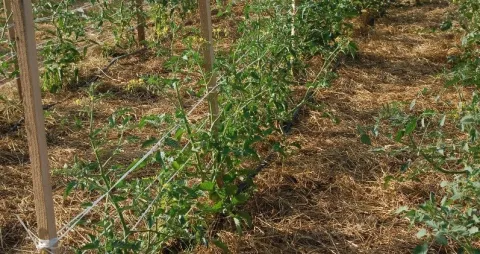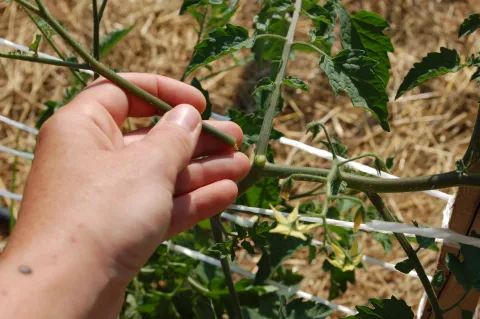Tomatoes Part IV: Plant Support & Pruning

In the third part of our tomato series, we discussed garden layout and water. In this edition, we will talk about plant support and pruning. This is an area where we can make it easier to manage our gardens and harvest the fruits of our labor. Also, depending on the type of tomato plant, pruning can yield larger fruit when the plant can devote as much energy as possible into fruit production.
PLANT MANAGEMENT
SUPPORT AND PRUNING
Proper plant management and support are needed to produce both the best yield and the best quality tomatoes. An added bonus of good plant management and support is that it can save time during picking.
Plant support
Tomatoes are normally supported with stakes or cages. Staking can be carried out for individual tomato plants or installed and tied as a row. If stakes are used, they should be durable hardwood about 4 to 5 feet tall for determinate types or 6 to 8 feet for indeterminate tomatoes. Aim to have about 1 foot of the stake length in the ground for stability. For individual staking, tie plants loosely to the stakes at 8- to 10-inch intervals. Make sure to use cloth or a string material that will not damage the stems as the plant weight increases. Stakes also can be placed every two plants and twine woven around them to form a basket that supports all the plants in the row. This method is sometimes called the “Florida Weave.” String is tightly stretched horizontally along both sides of the stakes at the same height, with plants held between the string layers (see Photo 1). Twine is wound around each middle stake to maintain tension and tied off at the end stakes. These layers of support are repeated every 8 to 10 inches vertically as the plant grows.
When cages are used for support, they must be strong enough to support the plant for the entire growing season. Cages can be purchased or constructed at home with materials such as concrete reinforcing wire. As a guide in cage construction, a 6-foot length of wire will form a cage about 21 inches in diameter. Cages should be well anchored in the soil to support the weight of the plants and fruit and allow access to ripe fruit for removal without damage.
Pruning
The method of pruning and plant management depends on the type of tomato and the method of support. Indeterminate tomatoes that produce fruit clusters and leaves throughout the season are commonly trained to a single stake or grown in a cage. If stakes are used, lateral branches (called suckers) are often removed to create a plant with a single main stem. Suckers can compete for plant resources and be a challenge to support on a single stake. The removal of suckers is less commonly practiced if tomato cages are used (Photo 2). Yields per plant are usually higher in a cage than when supported by stakes because fruit is harvested from both the main stem and lateral branches. Fruit may ripen slower in cages, but sunscald (fruit tissue death due to high temperatures) is often reduced.
Determinate tomato plants are generally pruned less than indeterminate plants, and some gardeners chose not to prune them at all. Because their main stem stops growing at a certain point, many of the fruit of a determinate tomato are produced on lateral branches. Determinate plants can be challenging to train to a single stake because of lateral branches, but cages and the Florida Weave system work well.
As the plants grow, they will require additional pruning. Prune out stems with yellow leaves or curling leaves. Also, prune non-bearing stems. Non-bearing stems will not have flowers, but will require energy to grow. Pruning should enable the plant to devote its energy to producing stems with leaves, buds, and fruit. Pruning damaged and non-bearing stems will increase sun penetration and air flow to the plant.
Sometimes a few leaves and lateral branches are removed below the first flower cluster because it can increase early yield and fruit size. It is best to leave one or two suckers below the first flower to avoid leaf curling, stunting and reduced yield.
In the next article, we will discuss ongoing fertilization and harvesting. For more information, please contact Shannon DeWitt, UT Extension Union County (865) 992-8038 or sdewitt@utk.edu
Written by Extension Agents: Shannon DeWitt, Anthony Carver, and Natalie Bumgarner
- Log in to post comments
